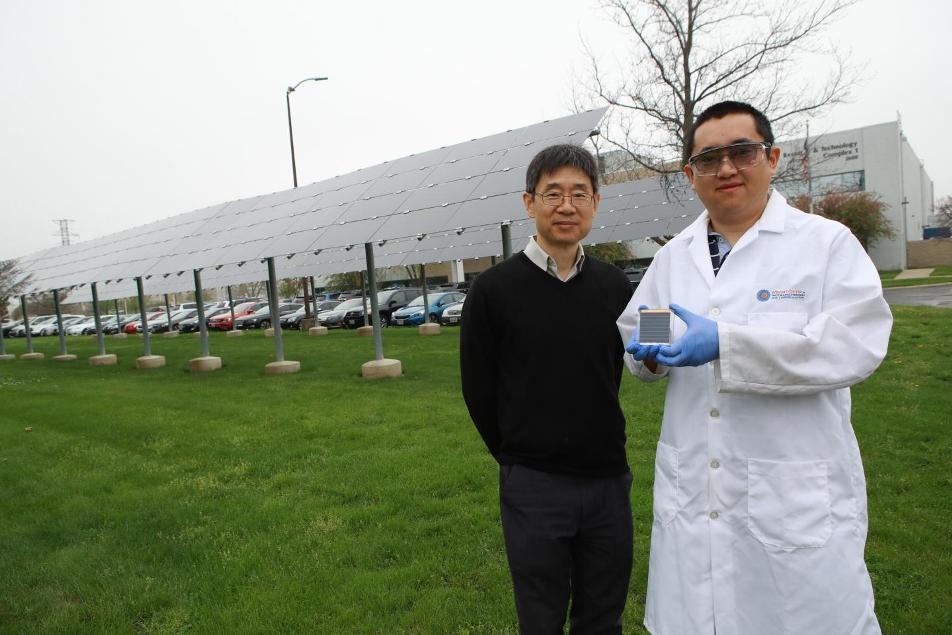May 15 2019
The most efficient and economical method to exploit the cleanest, most abundant renewable energy source in the world has moved closer to reality.
 Dr Zhaoning Song, research assistant professor in the UToledo Department of Physics and Astronomy, holds a perovskite solar cell mini-module he developed with Dr Yanfa Yan, UToledo professor of physics. The higher efficiency, lower cost solar cell technology could revolutionize energy generation around the globe. (Image credit: Daniel Miller, The University of Toledo)
Dr Zhaoning Song, research assistant professor in the UToledo Department of Physics and Astronomy, holds a perovskite solar cell mini-module he developed with Dr Yanfa Yan, UToledo professor of physics. The higher efficiency, lower cost solar cell technology could revolutionize energy generation around the globe. (Image credit: Daniel Miller, The University of Toledo)
A physicist from the University of Toledo who takes the performance of solar cells to levels never achieved before has made a major revolution in the chemical formula and process to develop the new material.
Working together with the U.S. Department of Energy’s National Renewable Energy Lab, Dr Yanfa Yan, UToledo professor of physics, visualizes that the ultra-high efficiency material known as a tandem perovskite solar cell will be ready for launch in full-sized solar panels in the consumer market shortly.
Perovskites, which are compound materials with a unique crystal structure developed through chemistry, would substitute silicon, which is currently the preferred solar-cell material for converting the sun’s light energy into electrical energy.
We are producing higher-efficiency, lower-cost solar cells that show great promise to help solve the world energy crisis. The meaningful work will help protect our planet for our children and future generations. We have a problem consuming most of the fossil energies right now, and our collaborative team is focused on refining our innovative way to clean up the mess.
Dr Yanfa Yan, Professor of Physics, University of Toledo
The new research paper, published in the journal Science, summarizes how the photovoltaics group is adjusting a combination of tin and lead for promoting the technology closer to its maximum efficiency. Currently, efforts have improved the efficiency of the new solar cell to around 23% when compared to the existing silicon solar panels, which have about 18% efficiency rating.
Researchers considerably enhanced the structural and optoelectronic properties of the lead-tin mixed perovskite films using a chemical compound known as guanidinium thiocyanate.
Science is the top academic journal in the world, alongside Nature, which published other research by Dr. Yan only five months ago after he discovered a single material that produces white light, which could boost the efficiency and appeal of LED bulbs. His significant sustainability work at The University of Toledo can help power the world using clean energy.
Dr Sanjay Khare, Professor and Chair, Department of Physics and Astronomy, University of Toledo
Yan’s group at UToledo discovered the ideal properties of perovskites around five years ago, and from that time onwards, he has focused his 20 years of experience on developing an all-perovskite tandem solar cell that integrates two different solar cells to improve the total electrical power produced by using two different portions of the sun’s spectrum.
The U.S. Department of Energy awarded Yan a $1.1 million grant in April 2019 to continue his work together with the National Renewable Energy Lab.
“This is the material we've been waiting for a long time,” Yan stated. “The solar industry is watching and waiting. Some have already started investing in this technology.”
Yan is a specialist in the theory of defect physics and electronic properties in semiconductors, thin-film solar-cell fabrication, and materials synthesis.
Our UToledo research is ongoing to make cheaper and more efficient solar cells that could rival and even outperform the prevailing silicon photovoltaic technology. Our tandem solar cells with two layers of perovskites deliver high power conversion efficiency and have the potential to bring down production costs of solar panels, which is an important advance in photovoltaics.
Dr Zhaoning Song, Study Co-Author and Research Assistant Professor, Department of Physics and Astronomy, University of Toledo
Yan’s group has enhanced the quality of the materials and the process to produce them at a low cost; however, more progress must be made.
“The material cost is low and the fabrication cost is low, but the lifetime of the material is still an unknown,” Song stated. “We need to continue to increase efficiency and stability.”
“Also, lead is considered a toxic substance,” Yan stated. “I am determined to work with the solar industry to ensure solar panels made of this material can be recycled so they don't cause harm to the environment.”